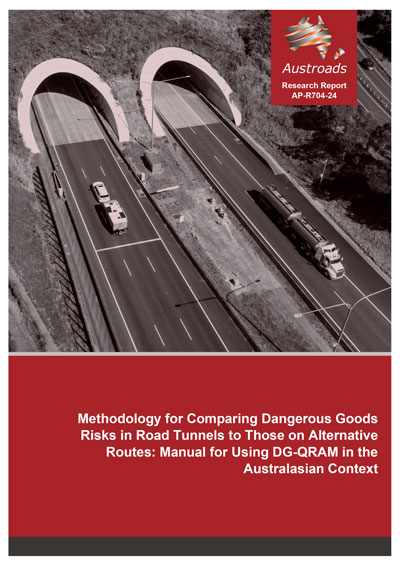Tunnels

- Publication no: AP-R704-24
- ISBN: 978-1-922994-19-6
- Published: 24 January 2024
- PDF (free) Download
This report is the second of the three reports produced as part of a project undertaken to establish a comparative risk assessment method for assessing whether a tunnel route is safer than a surface route for the road transit of dangerous goods (DG) materials.
This report provides background on the development, capabilities, and limitations of a Dangerous Goods Quantitative Risk Assessment Model (DG-QRAM) as well as guidance as to how the DG-QRAM tool should be applied to road tunnels in Australia and New Zealand.
The first report AP-R703-24 Methodology for Comparing Dangerous Goods Risks in Road Tunnels to Those on Alternative Routes: Best Practice Review presents best international practice in road tunnel DG risk assessment and provides justification for the selection of DG-QRAM as the tool most appropriate for comparative DG risk assessments.
The third report AP-R705-24 Methodology for Comparing Dangerous Goods Risks in Road Tunnels to Those on Alternative Routes: Case Study Using DG-QRAM in the Australasian Context illustrates the stages of the comparative assessment, with incorporation of mitigation measures. The case study is a demonstration of the intent of the method that is detailed in the manual.
Watch a webinar about the methodology with Dr Conrad Stacey and Nigel Casey.
- Summary
- 1. Introduction
- 2. Australasian Dangerous Goods Risk Assessment Method
- 3. Dangerous Goods Quantitative Risk Assessment Model
- 3.1 General Information
- 3.1.1 Scenario and Frequency Analysis
- 3.1.2 Consequence Analysis
- 3.2 DG-QRAM’s Official Guides and Reference Manual
- 3.2.1 User Guide
- 3.2.2 Guide For Expert Users
- 3.2.3 Reference Manual
- 3.3 DG-QRAM in the Broader Context of Quantitative Risk Assessments
- 3.3.1 Scenario-Based versus System-Based Assessments
- 3.3.2 Societal and Individual Risk
- 3.3.3 Injuries and Fatalities
- 3.3.4 Absolute and Comparative Approach
- 3.3.5 Road Users and Local Population
- 3.3.6 Damage Type
- 3.1 General Information
- 4. Application of DG-QRAM in the Australasian Method
- 4.1 Required Input Data
- 4.1.1 Information on the Tunnel Geometry
- 4.1.2 Information on the Tunnel Equipment
- 4.1.3 Information About the Assessed Routes and the Surrounding Area
- 4.1.4 Traffic
- 4.1.5 Incident Rates
- 4.1.6 Input Data Qualification
- 4.2 Required Adaptations of DG-QRAM in the Australasian Context
- 4.2.1 General Model Set-Up
- 4.2.2 Non-Placarded Transports of Combustible Liquids
- 4.2.3 Flammable Solids
- 4.2.4 Posted and Design Speeds (Urban/Rural Locations)
- 4.2.5 Truck Trailer Systems, B-Doubles
- 4.2.6 Fixed Fire-Fighting Systems
- 4.1 Required Input Data
- 5. Output
- 5.1 Representing the Results
- 5.2 Interpreting the Results
- 6. Accuracy Limitations
- References
- Appendix A Detailed Information about the Scenarios
- A.1 DG Fire Scenarios
- A.1.1 Fault Trees
- A.1.2 Physical Effects
- A.1.3 Scenario 2
- A.2 Explosion Scenarios
- A.2.1 Fault Trees
- A.2.2 Physical Effects
- A.3 Toxin Scenarios
- A.3.1 Fault Tree
- A.3.2 Physical Effects
- A.4 Bursting Tank
- A.4.1 Fault Tree
- A.4.2 Physical Effects
- A.5 Physiological Consequences
- A.1 DG Fire Scenarios
- Appendix B Additional Information on DG-QRAM’s Calculation Background
- B.1 Tunnel Cross-Section
- B.2 Incident Location within a Tunnel
- B.3 Evacuation Parameters
- B.4 Likelihood of Scenario Occurrence
- B.5 Delays Between Incident and Scenario
- B.6 Degree of Protection According to the People’s Surroundings
- B.7 Probit Functions, Lethality and Injury Limits
- Appendix C Explanations and Validations of the Method in the Australasian Context
- C.1 Empty Tanks
- C.2 Diesel
- C.3 Solid Flammable Dangerous Goods
- C.4 ‘Keep Right’ Rule
- C.5 B-Doubles
- C.6 Dangerous Goods Driver Training and Condition of the Trucks
- C.7 Emergency Services
- C.7.1 Beneficial Impact of Emergency Services Response
- C.7.2 Risk to Emergency Services Responders
- C.8 Fixed Fire Fighting Systems
- C.9 Mixed Loads
- Appendix D Fixed Fire Fighting Systems Risk Modification Factors
- D.1 General Approach
- D.2 TuRisMo Consequence Models
- D.2.1 TuRisMo DG-Fire Consequence Model
- D.2.2 Consequence Model for DG-Fire Scenarios with Explosions
- D.3 Effect of the Fixed Fire-Fighting System
- D.3.1 Reduction of the Fire Size / Heat Release Rate
- D.3.2 Shielding of Heat Radiation
- D.3.3 Effects on Smoke Layer
- D.3.4 Reduction of BLEVE Probability
- D.4 Scenario Variation
- D.4.1 Fire Scenarios
- D.4.2 D.4.2 Explosion Scenarios
- D.5 Model Tunnels – Base-Case and Deviating Characteristics
- D.5.1 Range of Validity
- D.5.2 Additional Tunnel Variants – Potentially Relevant Tunnel Characteristics
- D.6 Results
- D.6.1 Base-Count Tunnel
- D.6.2 Variants with Deviating Characteristics
- D.6.3 Modification Factors
- D.7 Conclusion and Discussion
